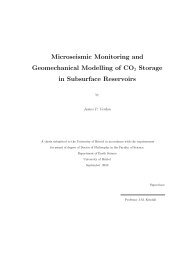MSAT - University of Bristol
MSAT - University of Bristol
MSAT - University of Bristol
Create successful ePaper yourself
Turn your PDF publications into a flip-book with our unique Google optimized e-Paper software.
where the repeated indices on the right hand side imply summation in this,<br />
and all similar equations. Similarly, if the stress is known the resulting strain<br />
can be calculated using the compliance tensor which (following the perverse<br />
logic <strong>of</strong> the stiffness tensor being labelled C) is conventionally denoted S:<br />
ε ij = S ijkl σ kl . (2)<br />
<strong>MSAT</strong> provides a range <strong>of</strong> functions for analysing and manipulating representations<br />
<strong>of</strong> elasticity and these are described below (section 3.2). Many <strong>of</strong> these<br />
contain implementations <strong>of</strong> different theories, however we will not reproduce<br />
these here: the reader is directed to the works referenced for that background.<br />
However, there are several pieces <strong>of</strong> theory which underpin several <strong>of</strong> the functions<br />
provided, which are worth covering briefly.<br />
The first <strong>of</strong> these is the symmetry exhibited by the elastic constants tensor.<br />
The symmetry <strong>of</strong> the stress and strain tensors implies that C ijkl = C jikl and<br />
C ijkl = C ijlk (the minor symmetries). Furthermore, it turns out that the<br />
stiffness tensor can be written as a function <strong>of</strong> the second derivative <strong>of</strong> the<br />
internal energy, U, with strain:<br />
C ijkl =<br />
∂2 U<br />
∂ε ij ∂ε kl<br />
, (3)<br />
and this results in the major symmetries: C ijkl = C klij . Taken together these<br />
symmetry relations reduce the 81 constants relating 9 stresses to 9 strains to<br />
21 distinct constants relating 6 stresses to 6 strains and these arguments apply<br />
equally to S. For convenience, elastic constants are usually representation using<br />
Voigt notation. This represents the 4th order tensor C ijkl as a symmetric 6×6<br />
5











